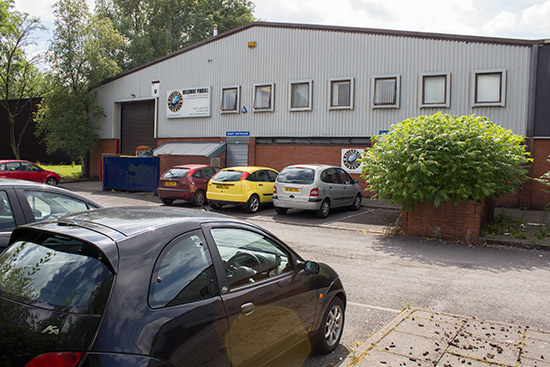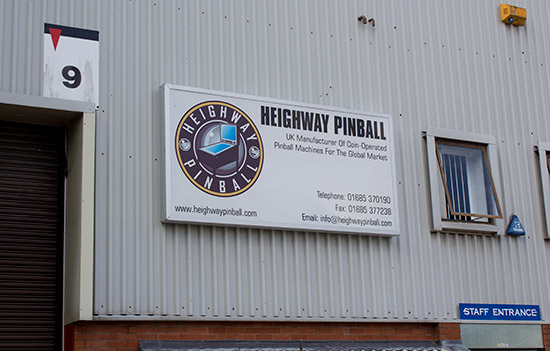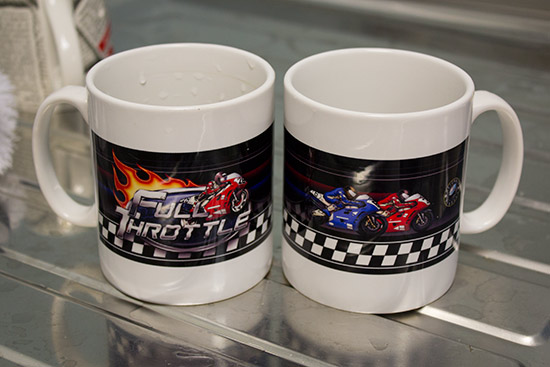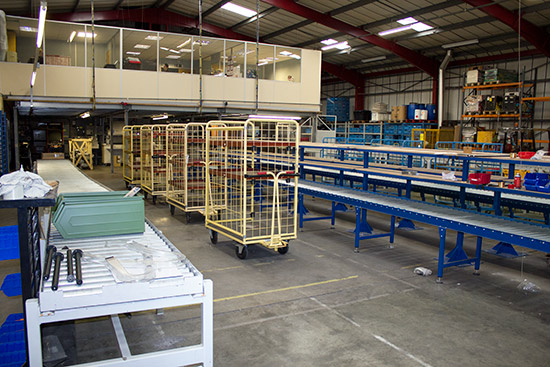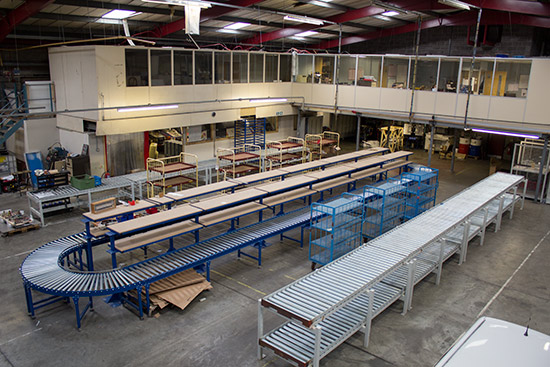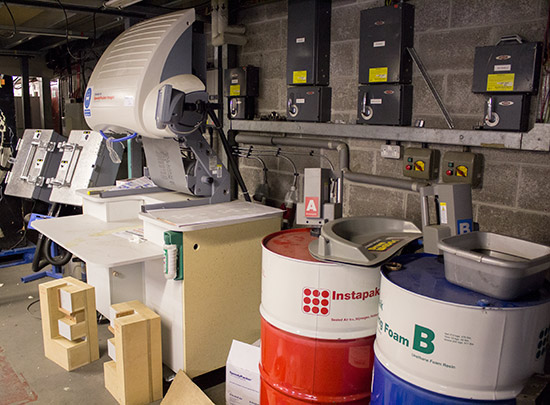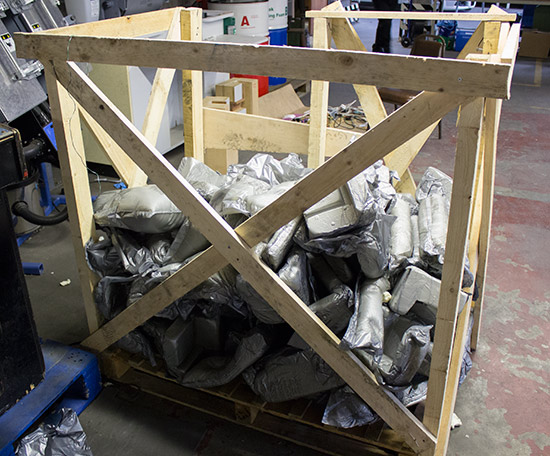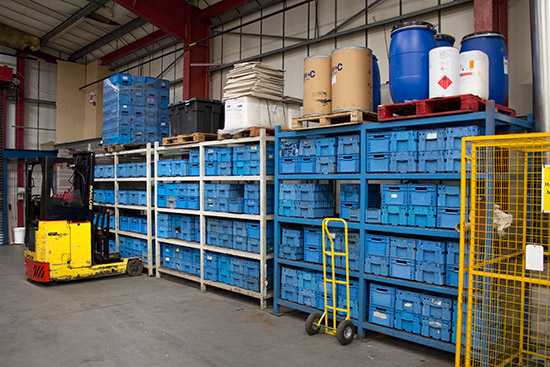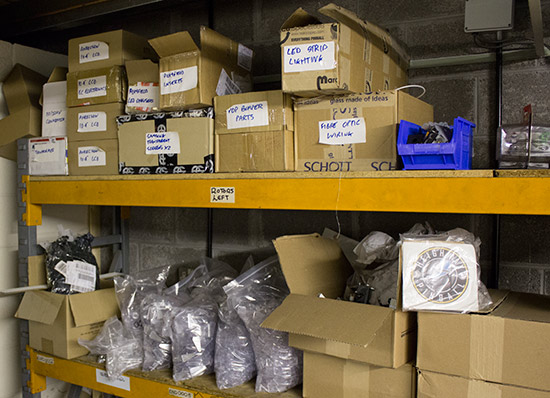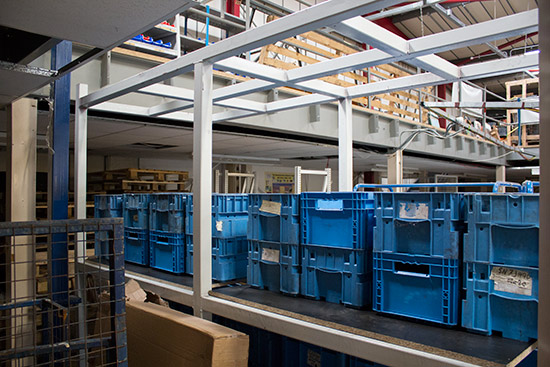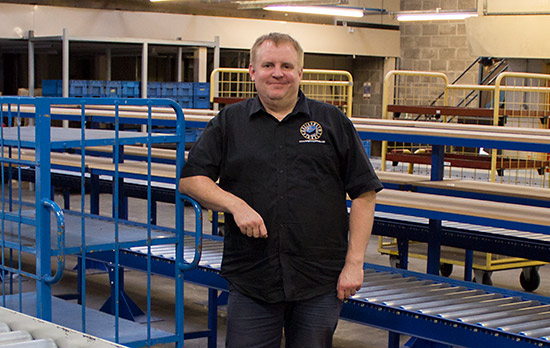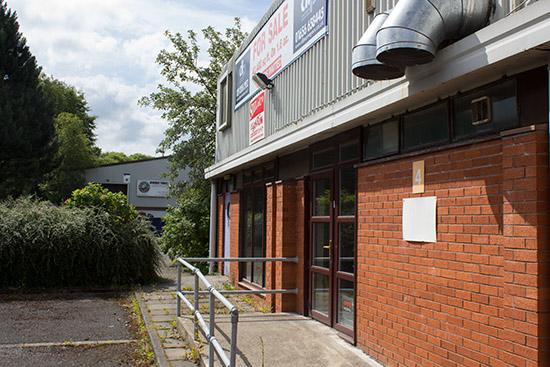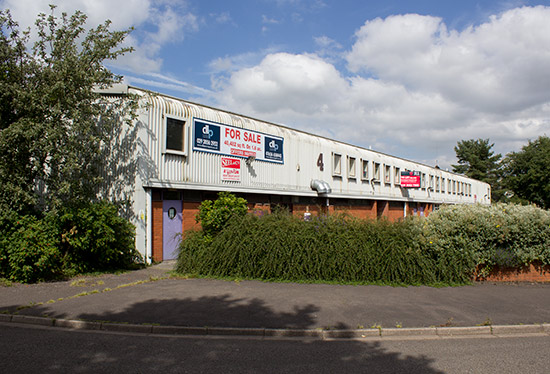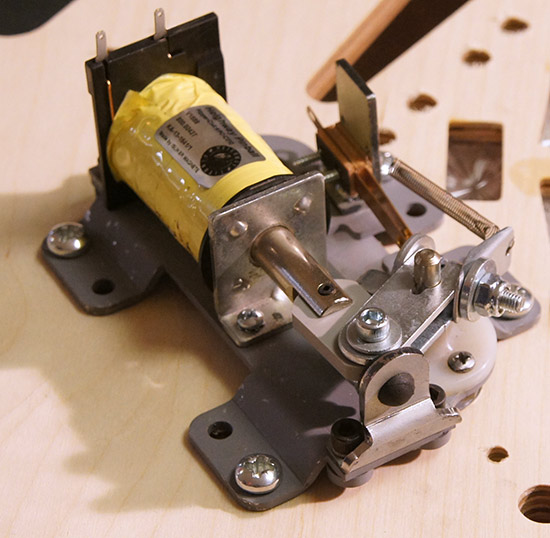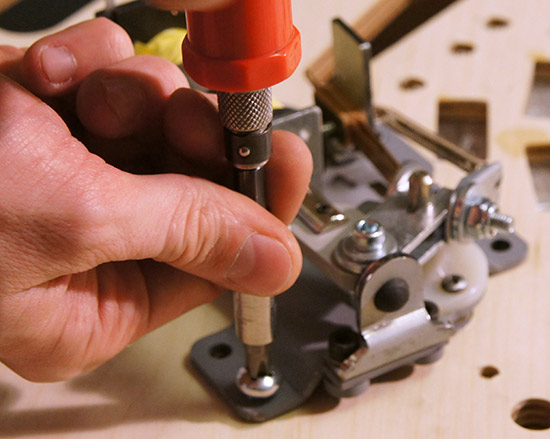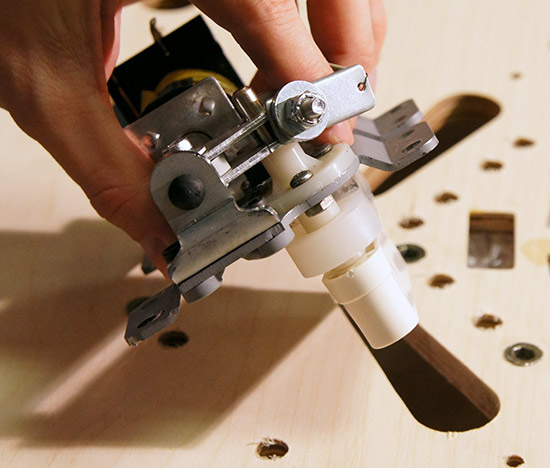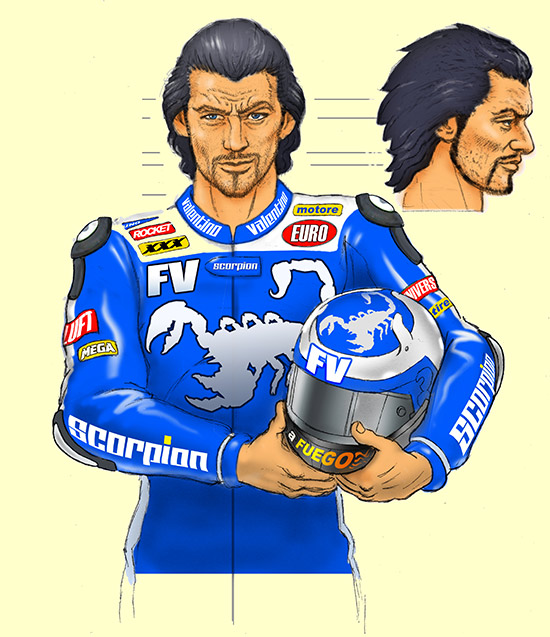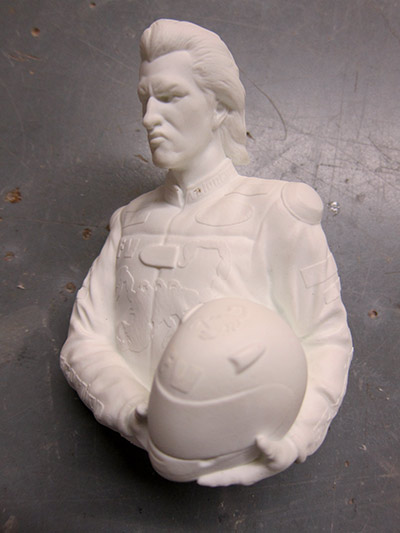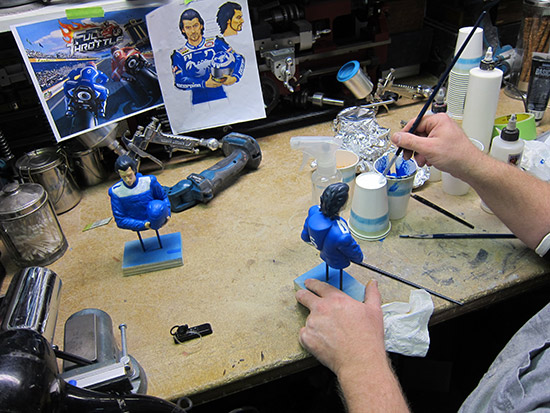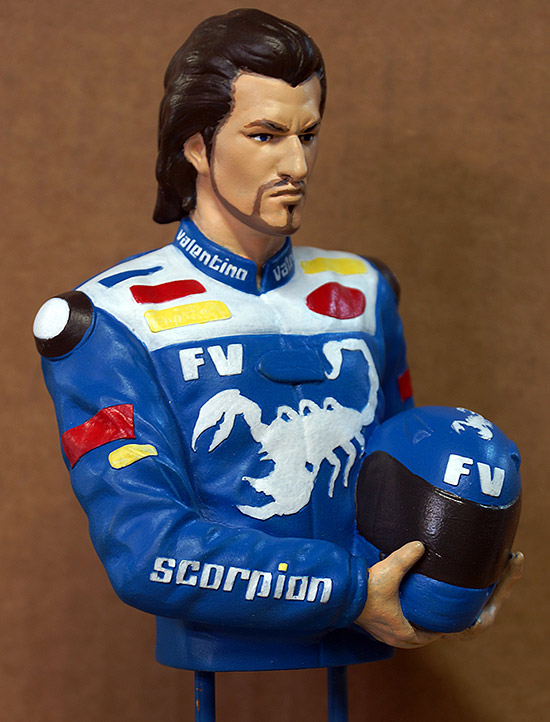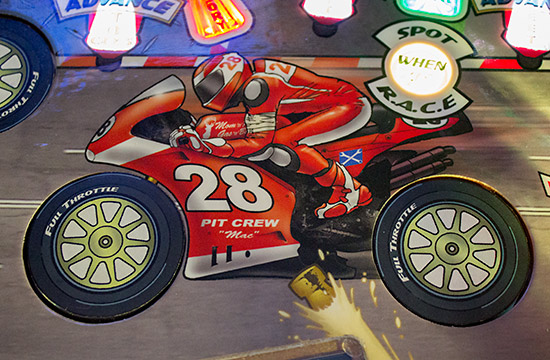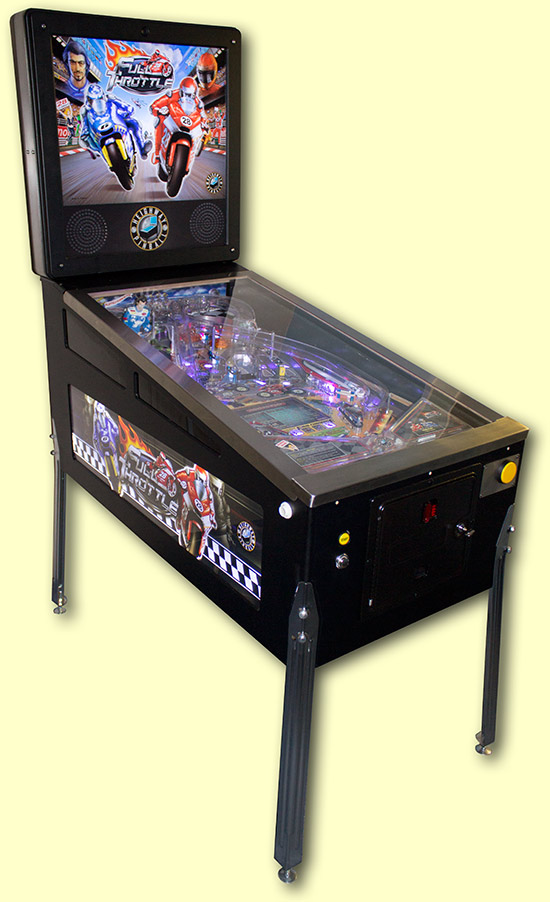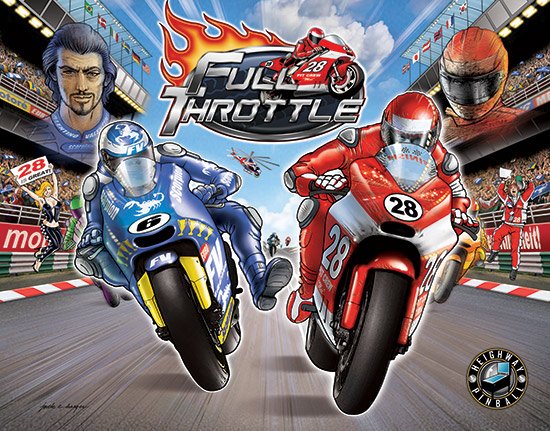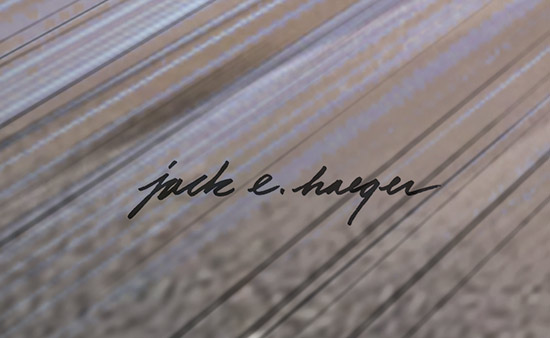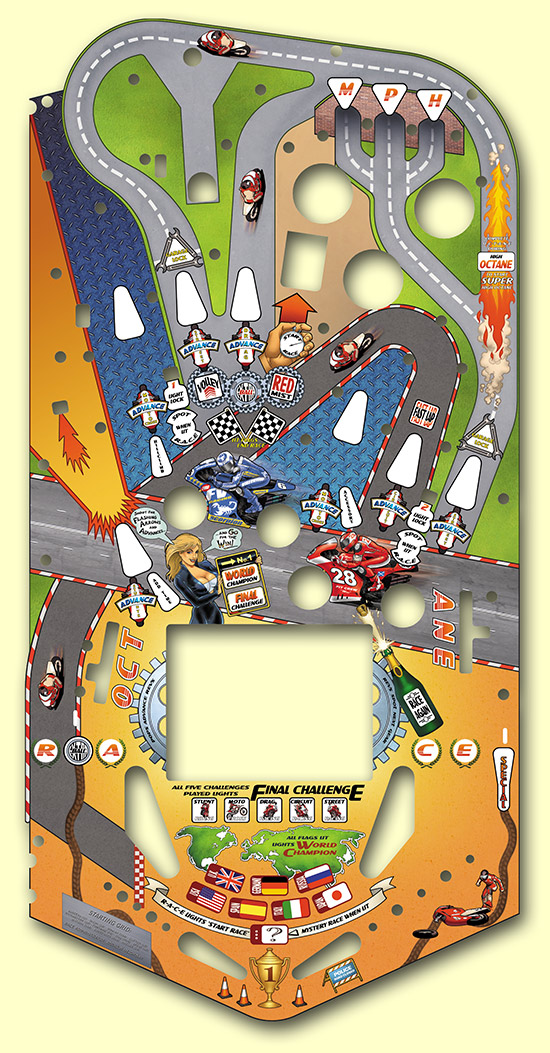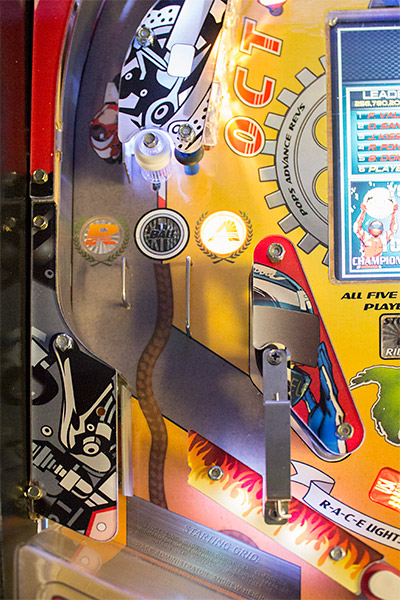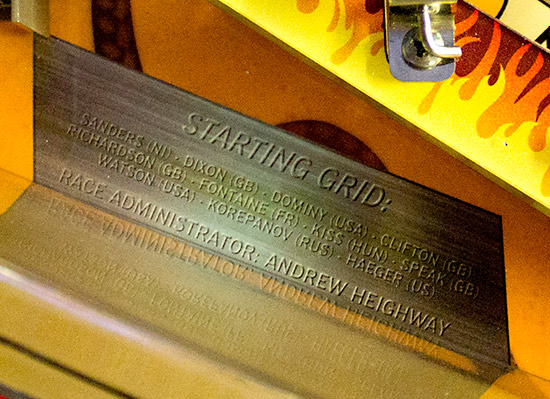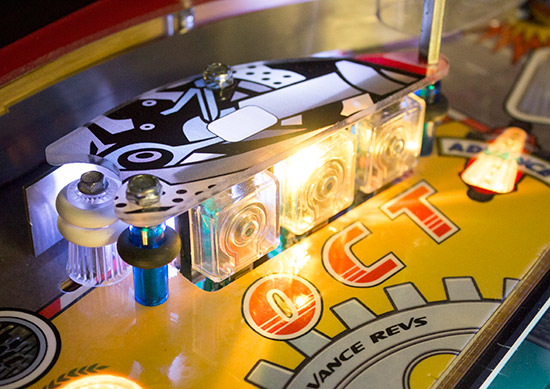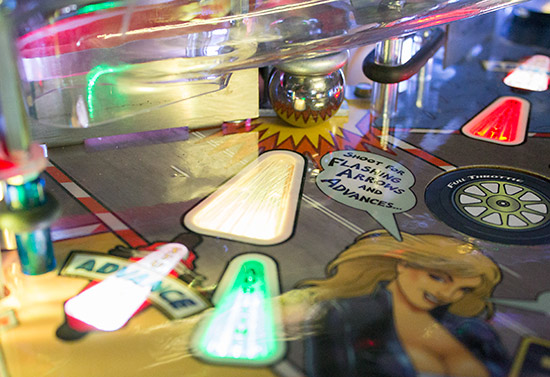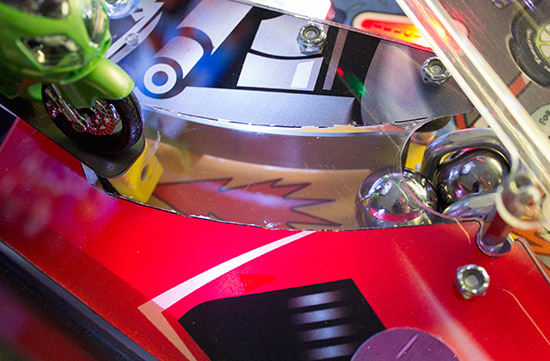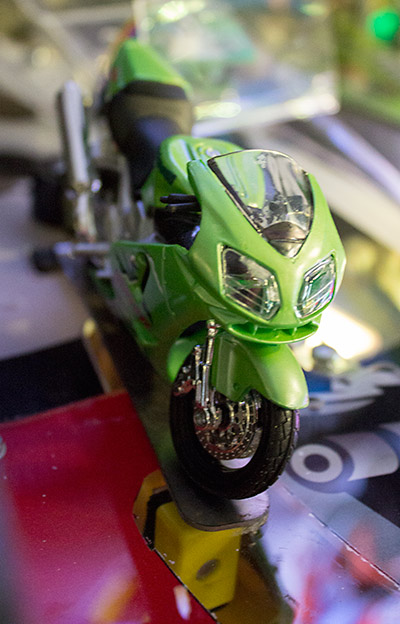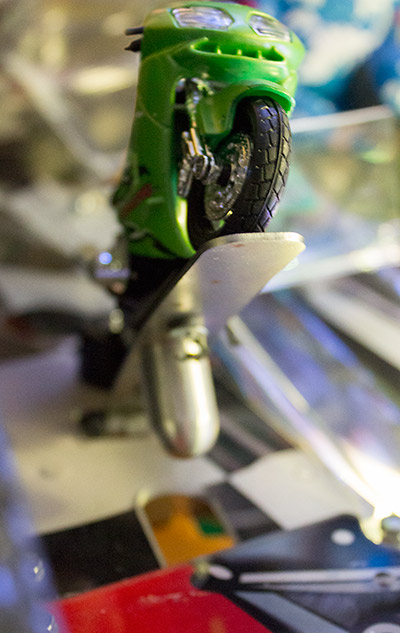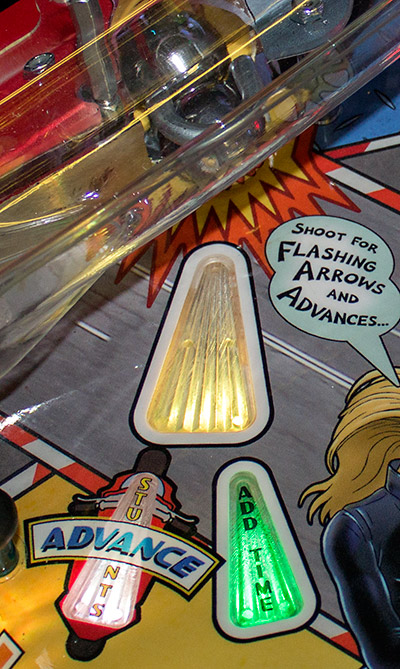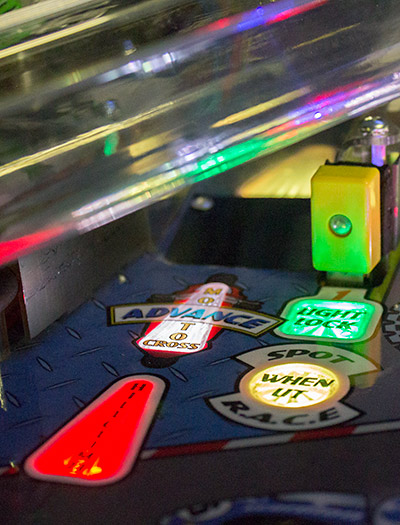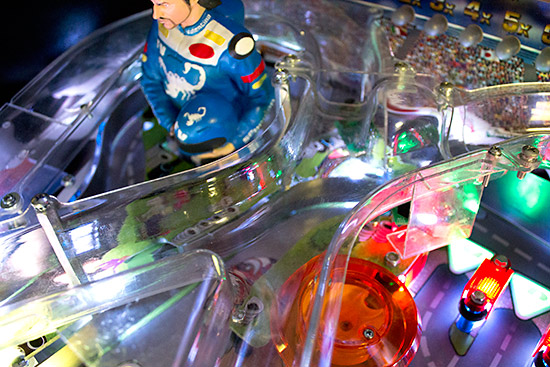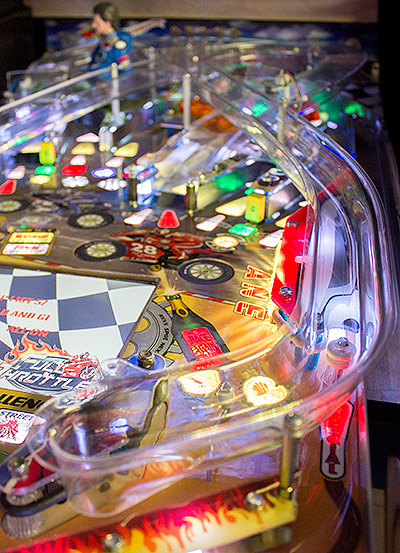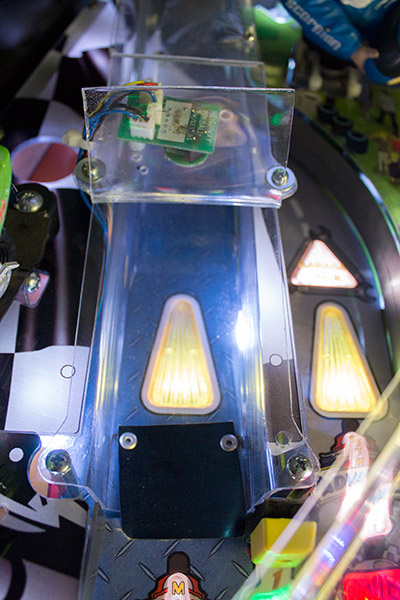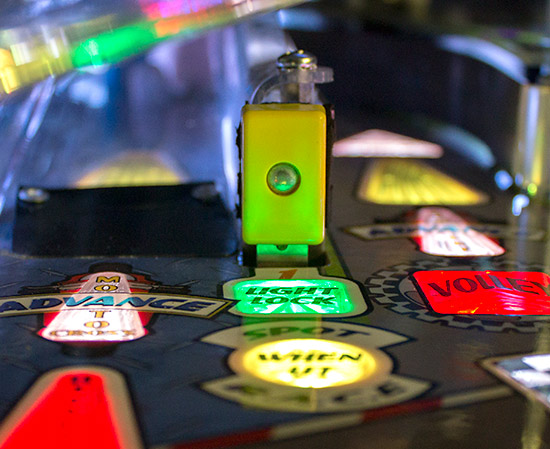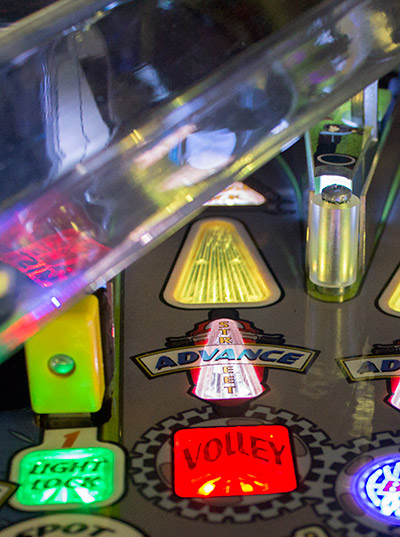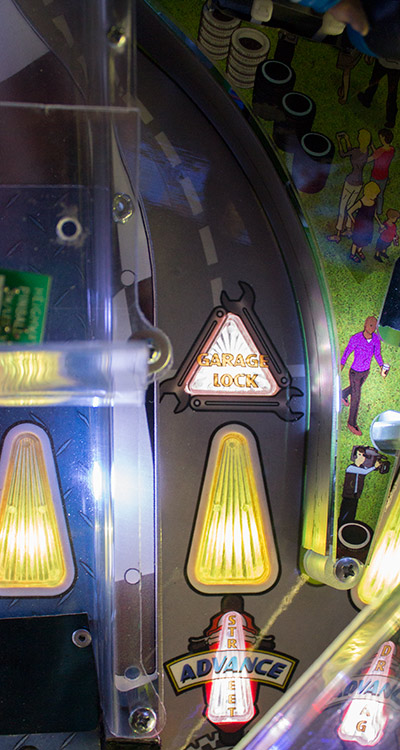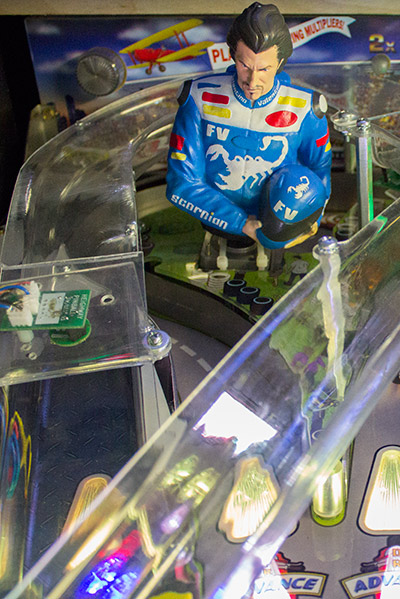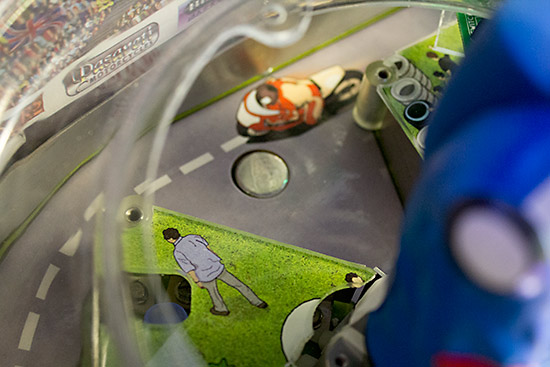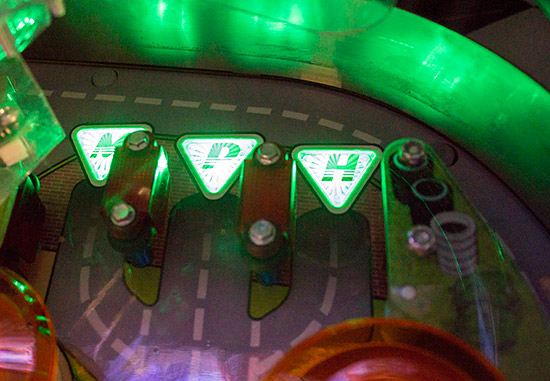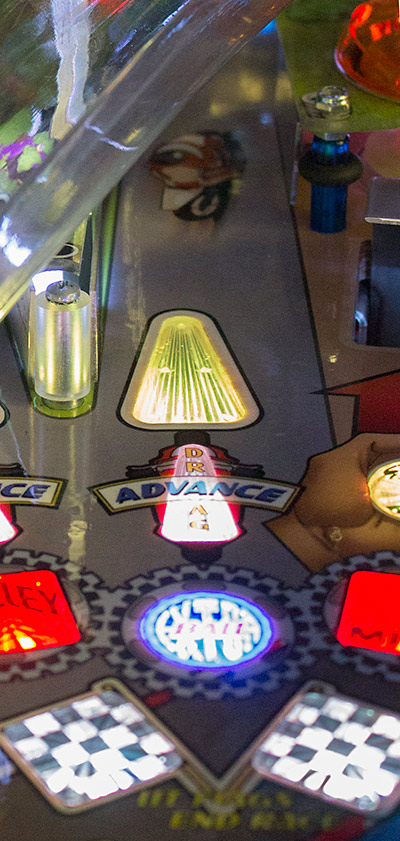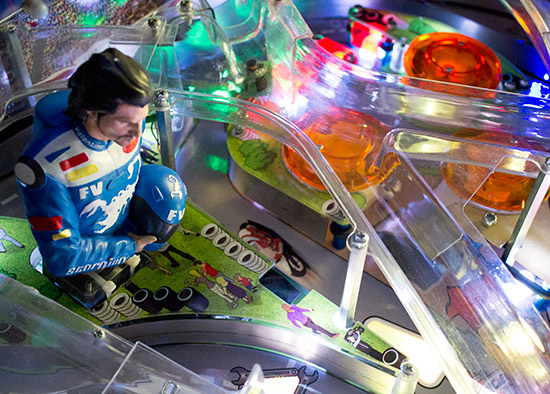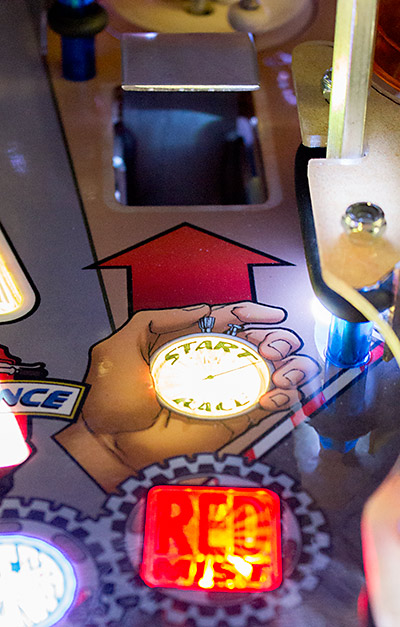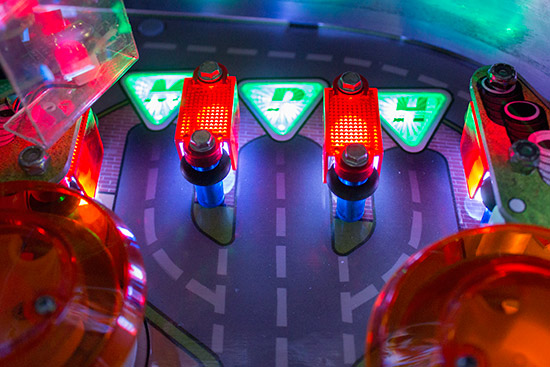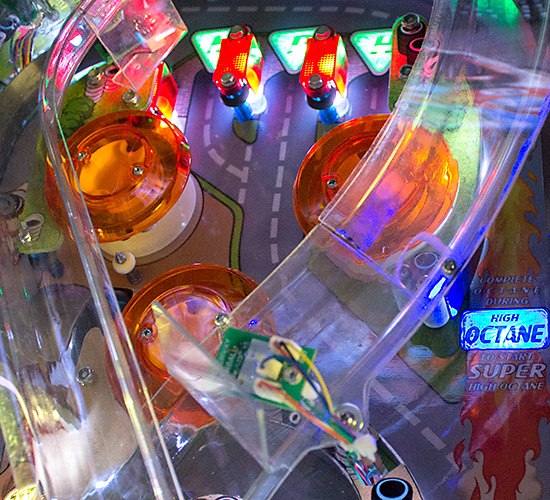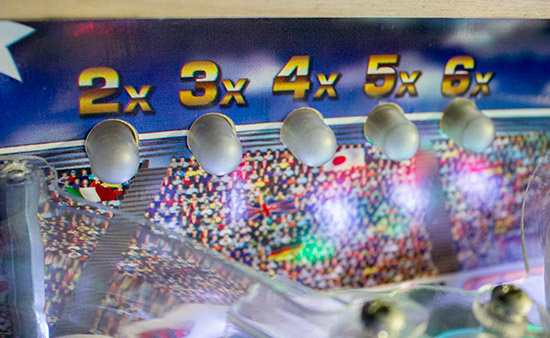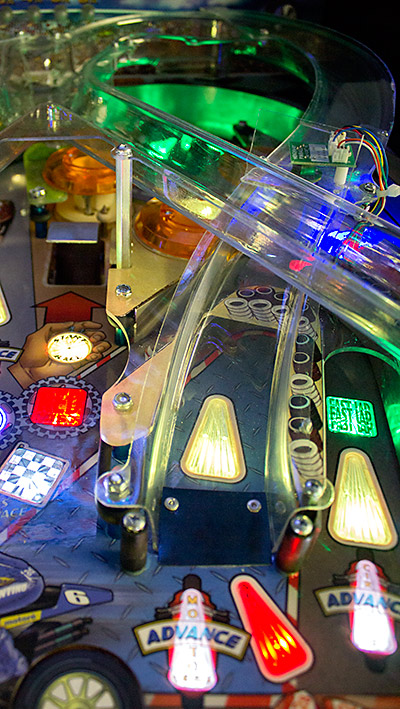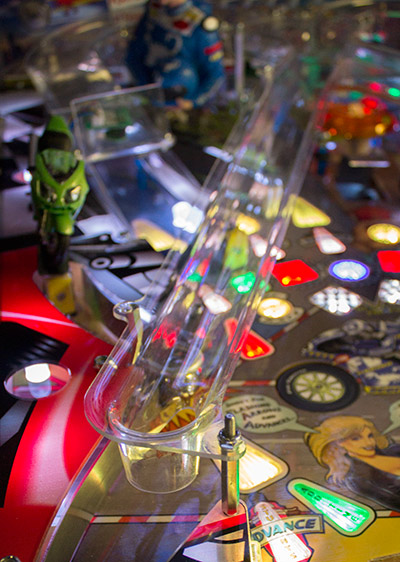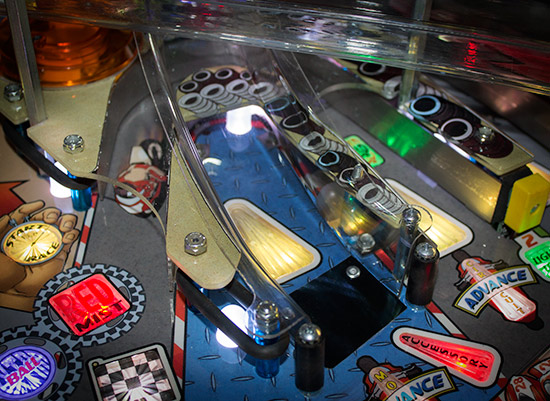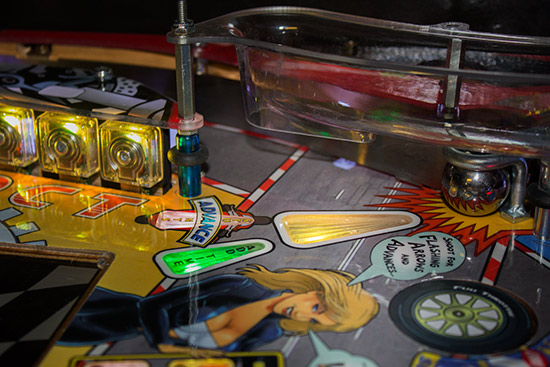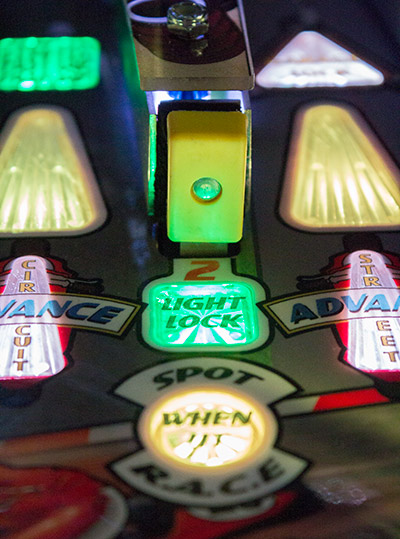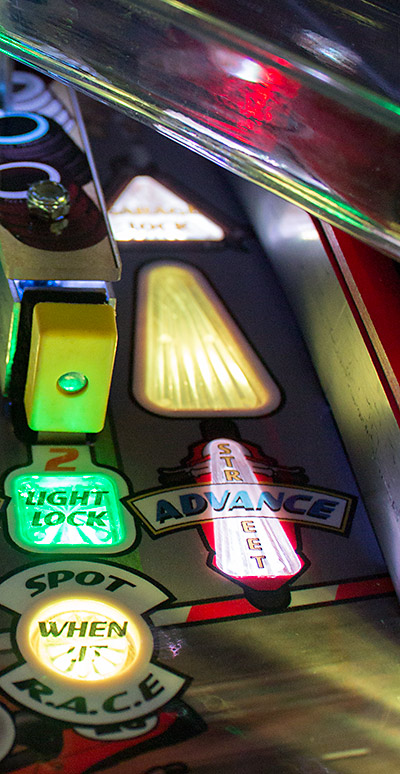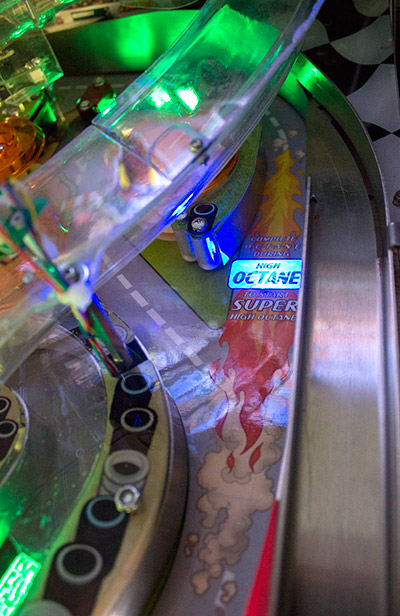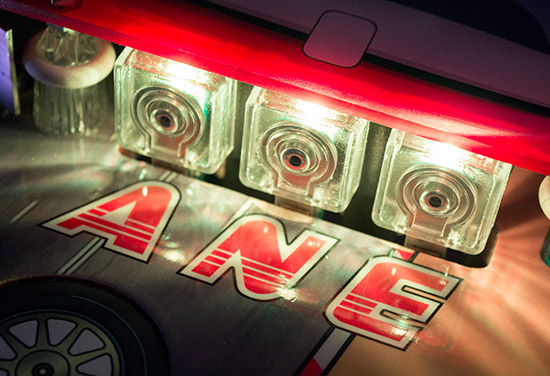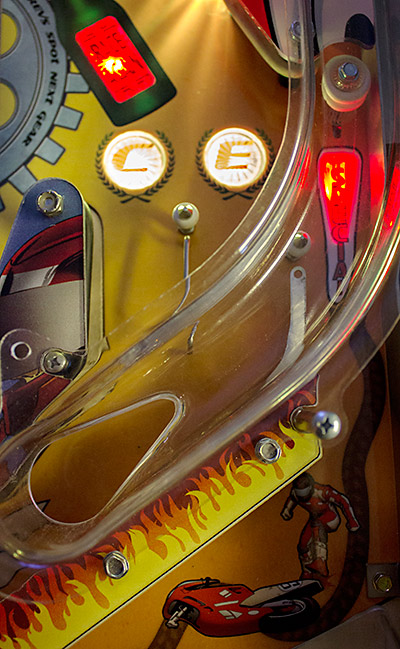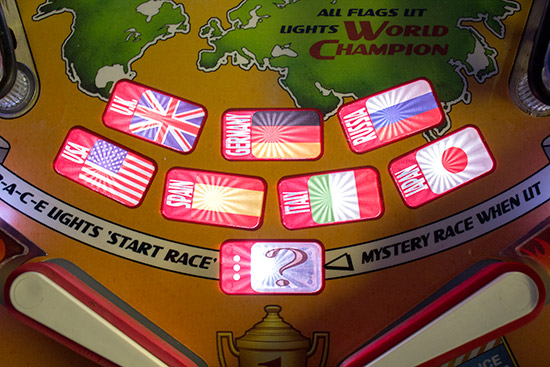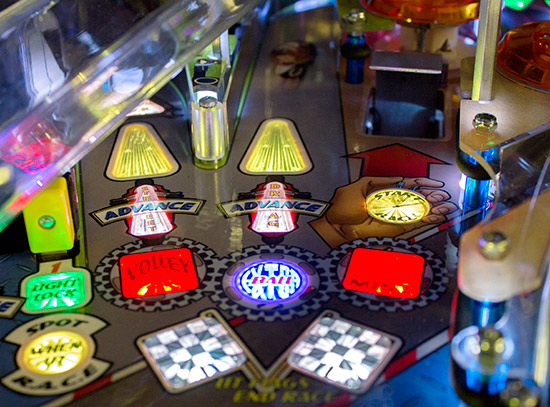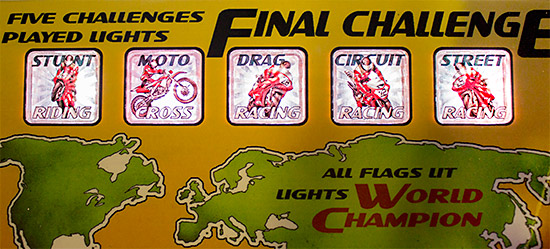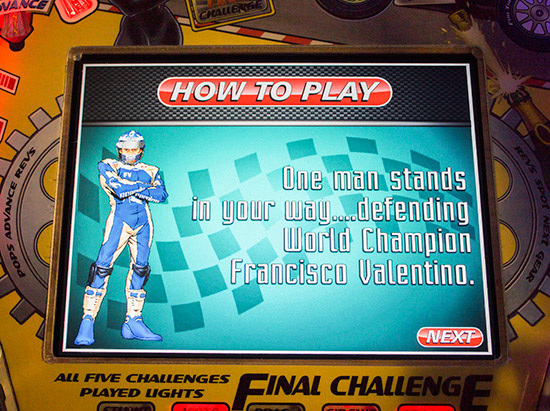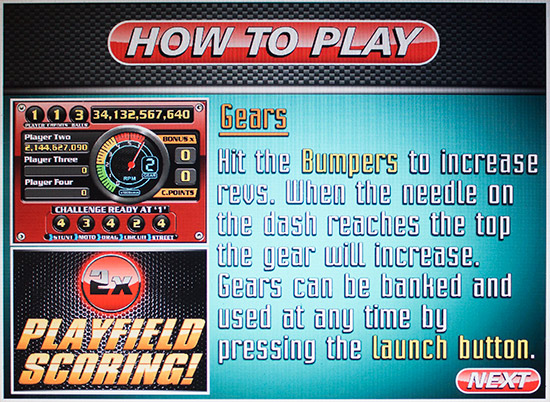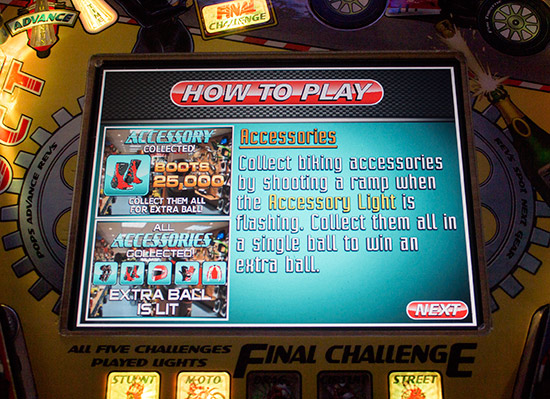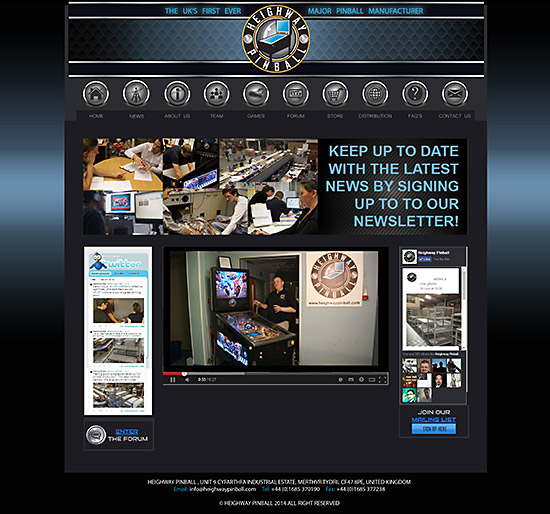HEIGHWAY PINBALL |
| Date: 29th July, 2014 Welcome to the second part of our update on the progress being made by Heighway Pinball and the current state of their first pinball - Full Throttle. We've got a lot of new and exclusive information, loads of pictures and even some video to bring you, so let's start by visiting the Heighway Pinball factory in South Wales. Located in Merthyr Tydfil, a town 20 miles north of the nation's capital, Cardiff, the former motor and drive train plant is on an industrial estate on the banks of the River Taff.
Knowing their first game is still a little way away, it was strange to see the car park full. But sure enough, walk through the entrance and all around the building people were working away setting up the production line, designing mechanisms, managing media assets, or programming and testing rules on an emulator or sample game.
In our previous report we told you about the amusement machine the company had produced for a global marketing campaign. It will be a little while before we can spill the beans and tell you more about that product, but right now the focus is squarely on Full Throttle.
We'll see how the game looks in a moment, but to make the game a reality and ready to sell in large numbers, you need production facilities. Let's go down to the factory floor.
The number of production line roller conveyors has increased and they now take up much of the floor space.
Below the offices, the Sealed Air Instapak foam packaging machine has been churning out those silver blocks which protect the games in transit.
Shelving units line the walls, and dozens of blue storage containers sit on them, awaiting the arrival of parts from suppliers around the world.
That's not to say there aren't lots of parts here already. Development of the company's first games calls for playfield inserts, pop bumper and flipper assemblies, LCD panels and much more.
But these are just a small fraction of what will be needed once production begins.
It's not hard to imagine how, once cabinets, backboxes and playfields are being built on the lines, the factory would quickly become filled to overflowing. Company boss Andrew Heighway saw that when their first amusement product was being built, and that was in smaller quantities than he expects for Full Throttle and the future games they currently have in development.
We took a walk outside, and Andrew pointed to the former Remploy factory on the opposite side of the road, which is now vacant.
If all the pieces fall into place, Heighway Pinball could move to this new larger factory which offers up to four times the floor space of the current building. Plus, the adjacent location will make transferring the existing equipment a fairly simple, if strenuous, task.
We should know whether this move will be going ahead in the next few days. Meanwhile, back in the current factory, the end is in sight for development of Full Throttle. There are still plenty of media assets to add to the game - sound effects, voice calls and display effects, but it is a far more polished and playable game than the last time we saw it. Andrew was keen to stress how the first game, like all their games, needs to have reliability as the number one priority if it is to appeal to operators. One of the major innovations which demonstrates this is the idea of modular playfield components, such as flippers, slingshots and pop bumpers. If a flipper plunger, link or coil needs attention, rather than trying to strip down the mechanism while it is upside down and attached to the playfield, simply unplug it and - with the removal of a few bolts - take the whole mechanism out so you can either swap it or work on it in a better location. The team demonstrated this on a test playfield.
It is this focusing on reliability which led to two important changes on the playfield. The 'chain drive' supercharger-like device which was to accelerate the ball before sending it back to the player has, after much experimentation, been taken out of the game. In its place is a model of game's antagonist and the tormentor of would-be challengers to his racing crown, Francisco Valentino. He is the top dog of the racing world and he knows it, taunting you as your try to gain victory over him. He began as a drawing, before being turned into a model and then painted.
Valentino is motorised and will rotate to follow the ball, while LEDs will illuminate him as he mocks your efforts to defeat him. Like the chain drive, the pop-up spinning bumpers representing the four wheels of the bikes were found to not be reliable enough when repeatedly struck at close quarters by the ball. The wheels still spin, but now act like mini-Whirlwind spinning discs to help disrupt the ball's path.
With those changes noted it's time to look at the whole game, where we're going to find a whole bunch more.
Let's begin with the cabinet and backbox artwork, because the Heighway Pinball team have listened to criticism of the previous art package and redesigned it, to make it more dynamic and convey the excitement of the race for the finish line. To achieve this, they have been working with artist Jack Haeger, who has developed numerous video game titles for Midway such as SiniStar, NHL Open Ice, Revolution X with Aerosmith, Terminator 2 and CarnEvil. He is also credited with co-creating the original concept which was later released as Al's Garage Band Goes on a World Tour by Alvin G pinball. But for retro-computing fans, Jack Haeger's greatest claim to fame is as one of the pioneers of digital art as Art & Graphic Director at Commodore-Amiga, in which role he appeared with Andy Warhol and Deborah Harry in 1985, as Warhol used an Amiga to create a digital picture of Deborah Harry. Jack has created this all-new translite for Full Throttle.
The new cabinet side art from Jack is illuminated by a back panel lit by LEDs, which give an even spread of light while allowing the art to be easily changed and maintaining cabinet security.
On the playfield there have been multiple changes, perhaps the 'biggest' of which is the move to a widebody format. The interchangeable playfield system meant the cabinet was already able to accommodate a widebody design, but previous iterations of the playfield didn't take full advantage of this capability. Now it does.
This change has allowed an extra inlane to be added on either side, and opened up the entrance to outer left inlane to make the inner loop shot more reliable and less dependent on individual machine setup.
Despite the change to a widebody design, the gameplay doesn't feel any slower than before, and the extra inlane on the left gives you a reasonable opportunity to save the ball. An adjustable post above the left outlane controls the difficulty of making that save, while the outlane can be lit to award an extra ball. You might notice the lack of any rollover switches in these lanes. This is because the game uses inductive switches mounted on small PCBs under the playfield to sense a ball passing overhead. By removing moving switch parts it is hoped to further increase reliability. In the artwork at the bottom of the left outlane is a plate containing credits for those who have worked on the game, along with their respective nationalities.
Positioned just inside the top of the outer left outlane are the first three O-C-T-A-N-E targets.
These are individually lit with internal RGB LEDs allowing them to illuminate in any of 16.7 million colours. There is a corresponding bank on the opposite side, and hitting all six targets lights the High Octane mode on the right orbit, which is a 'frenzy'-type feature where all switch activations score points. Completing the targets again will then kick you up to Super High Octane scoring. Combining this with a multiball mode could yield some serious points. Positioned above the left outlane is the game's captive ball feature.
This uses a traditional two-ball design, where the front ball is restrained while a second 'Newton' ball behind rolls up a lane and strikes a standup target to register the hit.
A toy bike is mounted on a plate at the back of the captive ball. When a shot is registered the bike rises to perform a wheelie. On this sample game the effect was only momentary, but it is expected to be held in the upright position for longer in the production version.
Like most of the major shots, hitting it will advance the associated challenge mode, which in the case of the captive ball is Stunts. It can also add more time to a race or other timed feature, and can be one of the required jackpot shots in multiball modes.
The entrance to the left ramp is the next shot on our tour of the playfield.
The left ramp entrance sends the ball up above the playfield and into an intersection, before sending it back to the right flipper. The left and right ramps merge into this single plastic, crossing each other before continuing on their individual paths.
The left ramp always feeds the right inlane, and the right ramp always feeds the left inlane, unless a collision occurs during a multiball mode. You might think having all that plastic in the central area could mean it is not properly supported, but we tested this and the whole ramp crossover was very solidly attached to the playfield and gave us no cause for concern.
The design of the end of the ramp is much more conventional than we saw in our earlier reports, meaning the ramps feel solid and release the ball without any bounceback or unnecessary delay. There are expected to be some changes up at the ramp entrances though. At present, the ball is sensed with another of those inductive sensors used below the playfield, only this time mounted overhead. However, the width of the ramp entrance and the height of the mounting means the ball can end up being too far away from the sensor for it to be detected consistently.
As a result, the sensor could change to become a roll-under microswitch instead. Whatever is chosen, it will be hidden behind a sign which be mounted above the ramp's entrance. To the right of the left ramp entrance is the first of two portrait-shaped standup targets.
Although this appears to be a regular standup, like the O-C-T-A-N-E targets it incorporates RGB LEDs. It uses an opaque yellow cover here but it may end up clear, with the colour defined by the LEDs within. Whatever colour it ends up, this target - along with its counterpart on the right side of the playfield, is used to light lock at the garage. Moving across the playfield we come to the left outer orbit shot.
It's unusual for an outer orbit entrance to be positioned inside corresponding the ramp shot, but this lane curves rapidly to the left to create a more familiar path up to the top of the playfield and give the ball some lateral movement as it passes under the left ramp.
The left outer loop curves around the model of Francisco Valentino, and is all set to feed the top rollover lanes.
However, there is a magnet behind Valentino which can grab the ball and drop it into the garage lock if the lock is lit.
This magnet can operate on balls travelling in either direction when the appropriate shots are qualified. The stopped ball drops into the garage behind Valentino which feeds into the scoop kickout. If the ball isn't stopped then it can either complete the orbit, or it can be stopped by an up-post and made to drop into the top rollover lanes. A second stop post can perform the same task for balls rolling the opposite way around the orbit lane.
But the outer orbit is not the only lane leading to the top rollovers, because to the right of the left outer orbit is the centre lane, and this too sends the ball up to the top of the playfield.
This centre lane sweeps to the right and feeds either those top rollover lanes or the right outer orbit entrance depending on whether the up-post intervenes or not.
Before we get to the top lanes though, there another shot in the centre which is quite tricky, but an important one to make.
The scoop is where all the races begin and where the balls locked in the garage exit. The kickout is straight to the flippers and reasonably fast, although not uncontrollably so. A mini-wizard mode - Red Mist - can also be started here once 7X playfield scoring is qualified. Behind the scoop is the left-most of the game's three pop bumpers. These are accessed through the three top rollover lanes which collectively spell out M-P-H and increase the bonus multiplier when completed.
The pop bumpers didn't contain LEDs in this sample game, but they will have them for production.
The main path out of the pop bumpers is shown by the road markings in the playfield artwork. This sends the ball into the right outer orbit lane and down to the flippers, but there is another exit on the left which drops the ball into the scoop and can collect whichever features are lit there. The bumpers increase the playfield scoring multiplier which is indicated on the back panel and can be collected by hitting the launch button.
Below the pop bumpers is the entrance to the right ramp.
The right ramp takes the ball up to the intersection and down to the outer left outlane, which then feeds it back to the left flipper.
Travelling under the right ramp's entrance is the game's inner loop.
The inner loop is designed to be a very quick shot which can be repeated for increasing points. The entrance is to the right of the right ramp, and the exit on the left directs the ball into the outer left outlane and back to the left flipper for a combo opportunity.
There are sensors on the entrance to the inner loop and in the left outlane, so it is hoped to add a speed champion award for the fastest inner loop shot. On the right of the inner loop's entrance is the second of the two lock standup targets.
This is the same as the target on the left side of the playfield, and both need to be hit and lit solidly to enable the lock. And where is that lock collected? At the garage, which can be accessed by shooting our last major shot, the right outer orbit lane.
Like most of the other major shots it advances its Challenge mode, and is also lit for jackpots, races, octane features, and, as we've just seen, to lock the ball in the garage. The outer orbit lane is also where newly-launched balls enter the playfield on their way up to the top lanes.
The game uses an auto-plunger, so there is no control of the strength of the ball launch. Further down the playfield we come to the second three-bank of illuminated standup targets which complete O-C-T-A-N-E.
As we get close to our starting point, we have the two inlanes on the right-hand side which are traditional in design and don't mirror the left side's layout.
The position of the inlane posts gave a tendency for the ball to bounce off the top of the right slingshot, onto the first post, onto the second and drop into the outlane. If it does you are in with a chance of collecting a special if it is lit. Otherwise, if you get an inlane it will light the corresponding R-A-C-E letter. The left ramp's return drops the ball after the inlane sensor, so you can't repeatedly shoot the left ramp to build up R-A-C-E letters from the inlane like you can with the right ramp. There are three important parts of the game located in the centre of the playfield, just above the flippers. The first is the set of countries in which you have to race.
The aim is to win each race by moving up the leader board into second place. Then you shoot the centre lane to take the chequered flags and beat Valentino. Each country's race will also have something unique about how it is played or the rewards on offer.
Starting a race is not overly difficult, but moving up the leaderboard and keeping time on the clock is much harder. Completing all seven races to get to the mystery race will not be an easy target to reach. Above the race inserts is another set for the five challenges. As we explained, most of the major shots has a challenge associated with it, and once you've made it enough times the challenge begins, although this could be changing in the next software revision to make the challenges stackable.
The biggest playfield item of them all is, of course, the LCD monitor.
The graphics have vastly improved since our last look at the game, with a much more polished look and feel. The images shown here are part of the 'teaching mode' which details the game's features and how to access them. The display is nice and bright, with very little fall-off in brightness compared to viewing it head-on, and no noticeable softening of the image.
There is still work to do though. The score display needs to be made more prominent, for instance, and more animation added to make the display less static at times. But these things are being worked on and there are some very nice animations already in the game.
Rather than try to describe the look and feel, let's show you. Here's our exclusive gameplay video of Full Throttle. Production is scheduled for October this year, with the first deliveries in November. Andrew said they held back from taking pre-orders until they were confident they were three months away for full production starting. Now that they believe they are in that position, pre-order prices for the standard edition of Full Throttle have been set as follows:
Payment can be made in stages, with a small £750/$1,000/€1,000 initial deposit, followed by a 50% payment the week of manufacturing, with the balance prior to shipping. A Limited Edition run of 250 machines will also be available which will include unique trim options, additional alternative translite and side art, a shaker motor, fibre-optic ramp lighting, an LE plaque with serial number, the playfield and/or translite signed by game designer Dave Sanders, an exclusive Full Throttle poster also signed by the game designer, and an exclusive goodie bag. A full list of unique LE features will be on the Heighway Pinball website. Meanwhile LE serial numbers 1-250 will be allocated on a first-come, first-served basis by contacting [email protected]. The prices for the Limited Edition model are:
Once again, payments for the LE begin with a small initial deposit of £1,250/$2,000/€2,000 with the same staged payment schedule and divisions as the standard model. US purchases will be fulfilled by Heighway Pinball from a central distribution point in Chicago, as will orders for replacement parts. The longer term intention is to set up an operational base there to manufacture cabinets for the North and South American markets. To coincide with the opening of pre-orders, Heighway Pinball launched their redesigned website at 21:00 GMT on Wednesday 30th July at heighwaypinball.com. It includes full details of how to order the game, the prices in various territories, payment options, the ability to sign-up to their newsletter, as well as exclusive Heighway Pinball and Full Throttle merchandise. Here's how their new website looks.
And this is their promo video for Full Throttle. There is also a special promotion to mark the launch of the new website and the official opening of pre-orders. Deposits for either model paid by midday GMT on Monday 18th August, 2014 will give a discount on the full price of £125/$175/€150. If full payment is made by the same deadline, those discounts are doubled. That brings us to the end of this exclusive update on what's happening at Heighway Pinball and their first game, Full Throttle. We hope you've enjoyed it. Remember, here at Pinball News we'll continue to bring you all the very latest Heighway Pinball news direct from the factory in Merthyr Tydfil, South Wales.
© Pinball News 2013 |

